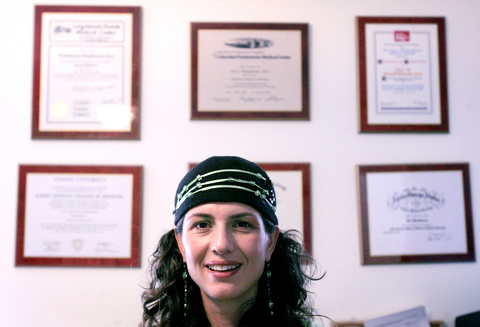Dr Orit Wimpfheimer rolls out of bed in her home in Israel each morning, walks downstairs and reports to her job -- on the East Coast of the US.
Wimpfheimer, an Ivy League-trained radiologist, analyzes test results from US hospitals over the Internet. She is among a growing number of American Jews who immigrated to Israel because they were able to earn a US paycheck and enjoy a lifestyle few Israelis ever see -- thanks to e-mail, Internet and video-conferencing.
"You get to move to the country of your choice. You get to do what you did before in the comfort of a home office," said Wimpfheimer, who lives in the Jerusalem suburb of Beit Shemesh.

PHOTO: AP
Lack of high-paying jobs has been a major obstacle for potential immigrants to Israel from the US and other wealthy countries. Unemployment in Israel hovers around 9 percent, and Israeli professionals typically earn a fraction of what their counterparts make stateside.
A few thousand Americans immigrate to Israel each year, a tiny percentage of the more than 5 million Jews in the US. But the number has grown in recent years, in part because people can bring well-paying jobs with them, said Daniella Slasky, director of employment at Nefesh B'Nefesh, a nonprofit agency that helps North American Jews move to Israel.
"I wouldn't say this is the reason for increased aliya," said Slasky, using the Hebrew word for Jewish immigration to Israel. "I think this is a tool that helps people move to Israel. It is much easier to make aliya, coming here and knowing you have a job. Also, having the American salary while living here is very significant."
She estimated that 20 percent to 30 percent of the breadwinners among the new arrivals from North America maintain jobs overseas. When Nefesh B'Nefesh began work four years ago, the number was negligible, she said.
Among those keeping US jobs are medical professionals, accountants, lawyers, graphic designers and computer programmers. All do most of their work in Israel, though some periodically commute to offices overseas.
STAYING ON
When Adam Lubov, a database administrator, decided to immigrate in late 2004, the medical software firm where he worked in Savannah, Georgia, asked him to remain on board. Since he already did most of his work from home, the transition was easy.
"I thought this was great. I can continue in my job, then look for something else," he said.
After he saw what he would earn in the local market, however, he decided to stay on.
"Seeing the pay difference, I can't do it," said Lubov, 28, who lives outside Tel Aviv.
Joel Pomerantz, a psychologist at an alternative school for at-risk children in Cleveland, supervises a team of five people from his home in Beit Shemesh. He checks into work about 3pm and works through midnight -- corresponding with the business day in Ohio.
Using the Internet, he can review results of tests administered by colleagues, prepare reports or enter information into a database. He meets regularly with parents and students via video-conference.
Pomerantz said the setup has been a natural fit for his school, called the Virtual Schoolhouse, which uses Internet learning to augment classroom activities. He said his tech-savvy boss suggested the arrangement, and he spent several months preparing before moving with his wife and three children in July.
While the distance has created some obstacles, Pomerantz, 31, said it has also yielded some benefits. Many parents are enthralled with the technology, and he has become more efficient because there are fewer distractions here.
"So far so good. I foresee this going really well," he said.
SACRIFICE
Some of the arrangements require creativity and sacrifice. Shye Wortman, an internist who moved to Beit Shemesh last year, still flies to New York every two weeks to treat patients.
When in Israel, he reviews charts and test results and speaks to patients by phone. Using Internet phone service, he even maintains a New York phone number.
"Some patients don't know I'm in Israel," he said.
Despite the travel, he says he now has more time with his family than he had in the US.
In other cases, the seven-hour time difference with the eastern US can be an asset.
Wimpfheimer, the radiologist, works from 6am to 3pm, teaming with two partners to cover the overnight shift at 18 hospitals in the northeastern US.
She reviews CT scans, MRIs and ultrasounds and exchanges information instantaneously over secure Internet connections.
The arrangement benefits the hospitals, which don't need to hire an overnight crew or force doctors to be on call during the bleary-eyed graveyard shift.
"It works much better," said John Breckenridge, chairman of the radiology department at Abington Memorial Hospital in Abington, Pennsylvania. "They're awake and alert."
And thanks to real-time technology, the distance isn't an issue.
"She could be in the next room. It really doesn't matter," he said.
Wimpfheimer, 36, a mother of six, can spend the afternoons with her children. With her US salary, she can live comfortably in a three-level suburban house with a swimming pool.
"The business is growing. We're having fun doing it," said Wimpfheimer, who immigrated from New York four years ago. "I wouldn't even consider moving back."

CHIP RACE: Three years of overbroad export controls drove foreign competitors to pursue their own AI chips, and ‘cost US taxpayers billions of dollars,’ Nvidia said China has figured out the US strategy for allowing it to buy Nvidia Corp’s H200s and is rejecting the artificial intelligence (AI) chip in favor of domestically developed semiconductors, White House AI adviser David Sacks said, citing news reports. US President Donald Trump on Monday said that he would allow shipments of Nvidia’s H200 chips to China, part of an administration effort backed by Sacks to challenge Chinese tech champions such as Huawei Technologies Co (華為) by bringing US competition to their home market. On Friday, Sacks signaled that he was uncertain about whether that approach would work. “They’re rejecting our chips,” Sacks

NATIONAL SECURITY: Intel’s testing of ACM tools despite US government control ‘highlights egregious gaps in US technology protection policies,’ a former official said Chipmaker Intel Corp has tested chipmaking tools this year from a toolmaker with deep roots in China and two overseas units that were targeted by US sanctions, according to two sources with direct knowledge of the matter. Intel, which fended off calls for its CEO’s resignation from US President Donald Trump in August over his alleged ties to China, got the tools from ACM Research Inc, a Fremont, California-based producer of chipmaking equipment. Two of ACM’s units, based in Shanghai and South Korea, were among a number of firms barred last year from receiving US technology over claims they have

It is challenging to build infrastructure in much of Europe. Constrained budgets and polarized politics tend to undermine long-term projects, forcing officials to react to emergencies rather than plan for the future. Not in Austria. Today, the country is to officially open its Koralmbahn tunnel, the 5.9 billion euro (US$6.9 billion) centerpiece of a groundbreaking new railway that will eventually run from Poland’s Baltic coast to the Adriatic Sea, transforming travel within Austria and positioning the Alpine nation at the forefront of logistics in Europe. “It is Austria’s biggest socio-economic experiment in over a century,” said Eric Kirschner, an economist at Graz-based Joanneum

BUBBLE? Only a handful of companies are seeing rapid revenue growth and higher valuations, and it is not enough to call the AI trend a transformation, an analyst said Artificial intelligence (AI) is entering a more challenging phase next year as companies move beyond experimentation and begin demanding clear financial returns from a technology that has delivered big gains to only a small group of early adopters, PricewaterhouseCoopers (PwC) Taiwan said yesterday. Most organizations have been able to justify AI investments through cost recovery or modest efficiency gains, but few have achieved meaningful revenue growth or long-term competitive advantage, the consultancy said in its 2026 AI Business Predictions report. This growing performance gap is forcing executives to reconsider how AI is deployed across their organizations, it said. “Many companies